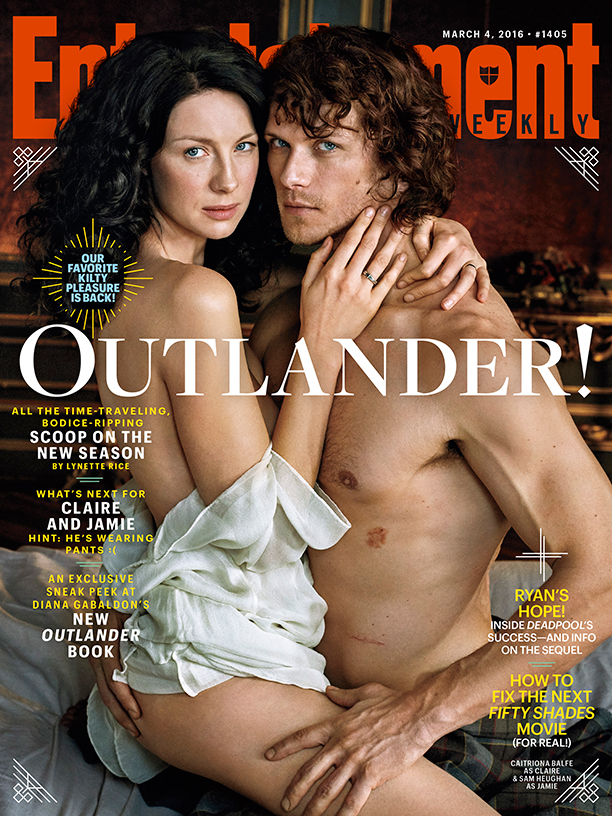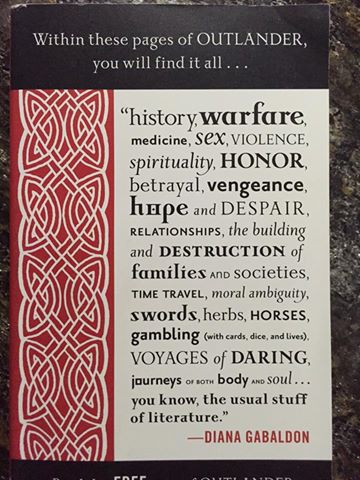(Disclaimer: Sarah’s opinion is in this post and is not indicative of all the writers on this site.)
I really want to know how to write air-quotes for the word controversy because this whole debacle is based on your opinion of the show and what is appropriate for television and the cover of a magazine. If you think the show is racy, then you probably think the EW cover is also racy. If you like the show in its entirety, but you think the EW cover is inappropriate . . . I don’t know what to say to that. If you love the book and the show in its entirety and you have a problem with the EW cover, I really, really don’t know how to respond to that.
In any case, fans of the books and the show were enough to rile Diana Gabaldon into a lengthy Facebook post on the subject. I really have to commend Diana for always addressing any sort of major rift in the fandom, whether it is the cover of a magazine or the casting of a character. This is her whole post on the subject:
Well, let’s see now. What you’re looking at (in the next post down) is a) the cover of a free giveaway edition of OUTLANDER, and b) the cover of the most recent edition of Entertainment Weekly, featuring a shot of Caitriona Balfe and Sam Heughan as Claire and Jamie Fraser.
(Btw, the cover on the left was written by me. Random House, a few years ago, decided to do targeted giveaways of OUTLANDER by street teams at public events, and they asked me what I thought about the cover for this promo edition. I didn’t like any of the sketches they’d shown me. They got fed up with me/ran out of time and asked me what I’d _like_ on the cover, so I wrote that little thumbnail run-down of the contents, and the resident genii of the art department promptly turned it into an appealing cover.)
OK.
1. What I’m seeing in the comments here is a pretty sharp divide over the EW cover, with a lot of people charmed or excited by it, and a lot of people disconcerted or displeased by it. [Make Note of this; we’ll be coming back to this point….]
2. Of the latter group, a large number object on moral or aesthetic grounds, considering the photo to be “smut,” “soft porn,” “raunchy” or otherwise unsuitable for public consumption by right-minded people.
3. Another large subgroup objects on commercial grounds, expressing the fear that a) this photo is a serious misrepresentation of both the Outlander TV show and the books it’s based on, and b) that viewing this cover will cause the uncommitted public to forever shun Outlander in all its forms because the photo is not properly representing the depth, complexity, historicity, and (as one person put it), “the appeal of married love and lives well-lived.” [Stop and think for a minute. Cover blurb: “A gripping story of married love and lives well-lived!” Ooo, I must have that…]
4. Am I perceiving things correctly? [Let me know if I’m misrepresenting anyone’s views here…]
OK. Before we get started here with My Thoughts (that sounds pretty pompous, doesn’t it? <g> Still, it _is_ my book, and this _is_ my page, so I think I get to have an opinion.)…let me briefly address the Romance issue (since “It looks like a cheesy romance novel!” is one of the oft-expressed negative opinions on the EW cover).A: I like well-written romance novels. I enjoy reading them, and have no hesitation in recommending them to people—you’ll find several romance authors on the Methadone List on my website (if you haven’t been over there, it’s www.dianagabaldon.com, and under the “Resources” tab, you’ll find “The Methadone List,” which is a list of books I feel comfortable in recommending to anyone who asks me “So what am I supposed to read while I’m waiting for the next Outlander book?!?”).
B. I don’t write romance novels. Besides being roughly four times the size of the usual romance novel, my books are not (with the exception of Outlander itself) courtship stories, and romance novels are. (Romance novels do not have sequels; when the main characters are mated, that’s The End.) The two unbreakable genre “rules” of a romance novel are that the story should be mostly concerned with the relationship of the two main characters, and that it should have a happy ending (though this term is slightly elastic). Well…sometimes you might get an optimistic ending from one of my books. Sometimes not so much… And while there are all kinds of relationships going on in my books (any novel has relationships), they often aren’t that sort, nor are they the main focus of the story.
C. All of this notwithstanding, I have seen my books sold as Romance, fairly frequently over the years. (I’ve seen them sold as Literature, Fiction, Historical Fiction, Science Fiction, Fantasy, Romance, Mystery, Military History, Gay and Lesbian Fiction, and Horror—all with reasonable accuracy.) Largely as a counsel of desperation by marketing people unable to think of any other way to draw anyone’s attention to enormous books that can’t be described. “Romance” is the single easiest aspect of a story to evoke, which is why you see couples on movie posters, TV ads, and book covers, no matter whether the film or book in question really is primarily a romance, or not.
What I mean to say here is—I have a LOT of experience in having my books called bodice rippers and seeing them published (in countries where I don’t have any personal control over the covers) with Really Strange covers. (The Korean one with the pink soap bubbles was one of the weirder ones, though I admit it didn’t have a heterosexual couple gazing into each other’s eyes….)
So. Let me say upfront that everybody sees things through the lens of his or her own experience, background, prejudices, and expectations. That includes me. I do, however, Just Possibly have a little _more_ experience in this arena than do most of y’all. So what I’m saying here is not intended to disrespect anyone else’s opinion, nor yet do I intend to come off as condescending, Marilyn <g>–it’s just that I probably have a wider perspective on the issues than most of y’all probably do, just by virtue of having been in these trenches for the last twenty-five years.
Awright. So here’s what I think, anent the EW cover:
a) I think I’ve seen racier underwear ads (mostly in Vogue).
b) If you honestly think this cover is “smut” or “soft porn,” then all I can say is that y’all should maybe get out more. If you’ve ever watched television in the UK, you’ve seen more explicit things than this three or four times in an evening. If you’ve been watching “Outlander,”(as theoretically you have) you’ve seen much more explicit sexual encounters on several occasions. Were these not “smut”? Is it OK to watch “soft porn” in the privacy of your home, but intolerable that other people should glimpse it on a magazine cover?c) Starz promoted Season One with “The Kilt Drops [date]”, in print ads, ads on the sides of busses and ads the height of ten-story buildings. I didn’t see a word of protest that this was “cheapening” our beloved story, or reducing it to the “level of a Harlequin Romance”. * Why were you totally OK with that bit of sexual innuendo, while the words “Bodice-ripper” (on the cover of a single magazine) makes you foam at the mouth? Is it OK to enjoy male-directed sexual innuendo (and grope kilt-wearing men), while it’s All Wrong to see female-directed sexual references in print?
d) For that matter…look at the post _under_ the one we’re discussing. This is from the EW site, but it shows a still from the show that I’ve seen reproduced all over the internet since last year. It shows Jamie and Claire in a pose that’s explicitly either pre- or post-sex, and (apparently) totally naked. Did I hear a word of protest about this? Why, no, I didn’t. I heard mass swooning and sighing. So—e) Evidently (for some) it’s the juxtaposition of “bodice-ripper” and “kilty pleasure” with the photograph that gripes you. Well, I’m totally with you, there—but as I say, that’s been happening to my books ever since the first publication of “Outlander.” For a great many people (and virtually all marketing people…) “historical romance” = “bodice-ripper,” and they don’t see or intend anything negative by that term; they just figure that’s what you call “that” sort of book. Stubborn resistance will gradually wear them down, but you have to keep at it—take it from one who routinely rewrites the cover copy on her ads and books…
f) For those complaining that the EW cover doesn’t properly express the depth, complexity, etc. of the story (books or show)…well…no. It doesn’t. Would you like to suggest a pictorial cover that a) _would_ express that, and b) would appeal instantly to a wide audience? It’s one image; there’s no conceivable way for a single image to encompass this story, or a fraction of it. A magazine cover is meant to do _one_ thing: attract eyeballs. With luck, said eyeballs will zip to Jamie and Claire, but will also see the word “Outlander”.g) The giveaway cover that _does_ more or less describe the contents accurately is not one that would work on a magazine like EW. _The Atlantic Monthly_, maybe, but not EW. Question of style and audience, aye?
h) It’s _one_ magazine cover. To assume on the basis of this that the whole world will gasp in horror and make a note circled in red to Avoid Watching Outlander, at all costs, is…perhaps a trifle over-reactive.i) [Returning to Point 1, above…] God bless those of you who _did_ express outrage, concern, or dissatisfaction, whatever your motives for doing so. <g> Because nothing—and I do mean nothing—makes more effective publicity than controversy. By objecting and writing blog posts and heated comments, you’ve done more to stimulate interest in the show (and by extension, the books) than the EW piece could ever have achieved had it been received with universal approbation by fans. So thank you!
*Pretty sure none of you who’ve used this particular disparagement regarding the EW cover have ever seen a Harlequin Romance, nor do you know what they are. I have, and I do. (Besides being a lifetime member of the RWA—and SFWA, and the Author’s Guild, and a few other organizations—I used to judge finalists in the Historical Fiction category for the RITA Awards (the RWA’s award for excellent romance fiction **).) One of the best historical romance novels I found was THE PRISONER, by Cheryl Reavis. It’s a Harlequin Historical, and it’s a great book; if you ever find a copy on Alibris or Abebooks, I recommend you grab it.
Harlequin romances have very strict guidelines as to length and content. So do sonnets and villanelles. Neither length nor guidelines have anything to do with the quality of writing or story.
** When OUTLANDER was published in 1991, it was nominated in four different RITA categories (it was also nominated for the Nebula ballot, fwiw). I told my husband at the time that it wouldn’t win any of the categories, and I was right: at the time, RITA judging ballots had numbers from 0-6, with 6 being, “This is the best book I’ve ever read; I wish I’d written it myself,” and 0 being “This isn’t a romance.” Back in the day, they _showed_ entrants what their scores were: mine were evenly divided between 0’s and 6’s. I _did_ win the “Best Book of the Year” award—that was an award voted on by the membership at large (rather than judged), and at the time, there were no genre limitations; any book could be nominated.
Source: Diana Gabaldon

